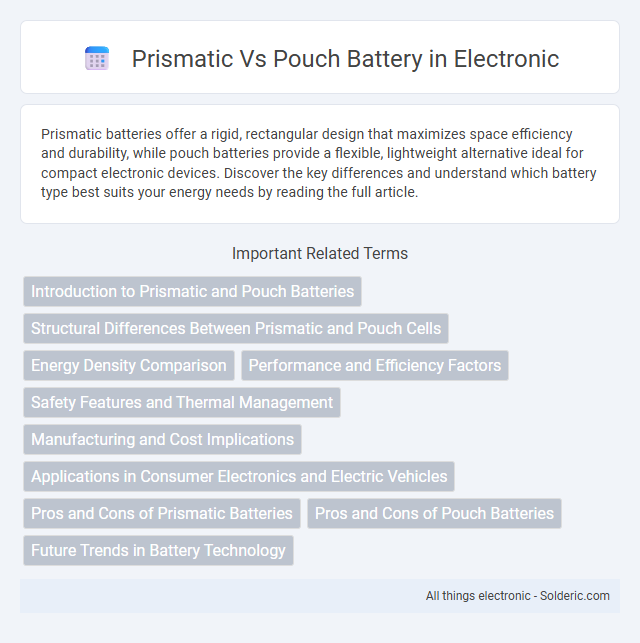Prismatic batteries offer a rigid, rectangular design that maximizes space efficiency and durability, while pouch batteries provide a flexible, lightweight alternative ideal for compact electronic devices. Discover the key differences and understand which battery type best suits your energy needs by reading the full article.
Comparison Table
| Feature | Prismatic Battery | Pouch Battery |
|---|---|---|
| Form Factor | Rigid rectangular metal casing | Flexible, lightweight laminated pouch |
| Energy Density | Moderate (150-250 Wh/kg) | High (200-300 Wh/kg) |
| Weight | Heavier due to metal casing | Lighter, reduces overall pack weight |
| Durability | High mechanical protection | Less durable, requires protective casing |
| Manufacturing Cost | Higher due to metal case and assembly | Lower, simpler packaging process |
| Thermal Management | Better heat dissipation via metal case | Challenging due to flexible packaging |
| Application | Electric vehicles, stationary storage | Consumer electronics, EVs, drones |
| Swelling Risk | Minimal swelling, structurally stable | Higher swelling risk, needs pressure control |
Introduction to Prismatic and Pouch Batteries
Prismatic batteries feature a rigid rectangular casing typically made of metal, providing enhanced structural integrity and space efficiency ideal for automotive and large-scale energy storage applications. Pouch batteries use a flexible aluminum-laminated polymer envelope, allowing lightweight, customizable shapes and improved energy density, making them popular in portable electronics and electric vehicles. Both battery types utilize lithium-ion chemistry, but their design differences impact durability, thermal management, and manufacturing cost.
Structural Differences Between Prismatic and Pouch Cells
Prismatic batteries feature a rigid metal casing that provides structural support and protection, while pouch batteries use a flexible laminated foil pouch that reduces weight and allows for varied shapes. The rigid design of prismatic cells enhances durability and thermal management, whereas pouch cells offer higher energy density due to their lightweight and compact structure. Understanding these structural differences can help you select the optimal battery type for your application, balancing strength and space efficiency.
Energy Density Comparison
Prismatic batteries typically offer higher energy density compared to pouch batteries due to their rigid structure that allows for better space utilization and thermal management. Pouch batteries, while more flexible and lightweight, generally have lower energy density because their soft casing limits the amount of active material that can be packed within the same volume. The energy density of prismatic cells can reach up to 250 Wh/kg, whereas pouch cells usually range between 150 to 200 Wh/kg depending on the specific chemistry and design.
Performance and Efficiency Factors
Prismatic batteries offer higher energy density and better thermal management, leading to improved performance in high-drain applications compared to pouch batteries. Pouch batteries provide greater flexibility in shape and lighter weight, enhancing efficiency in compact designs but may suffer from swelling issues affecting long-term stability. Both battery types' efficiency depends on factors such as discharge rates, cycle life, and heat dissipation characteristics tailored to specific use cases.
Safety Features and Thermal Management
Prismatic batteries feature robust casing that enhances physical durability and incorporates integrated thermal management systems to prevent overheating and ensure stable operation under high loads. Pouch batteries, with their flexible, lightweight design, require advanced thermal regulation techniques such as external cooling layers and pressure-sensitive safety vents to mitigate swelling and thermal runaway risks. Your choice between prismatic and pouch cells should consider the specific safety protocols and thermal management capabilities suited to your application's operational demands.
Manufacturing and Cost Implications
Prismatic batteries feature a rigid rectangular casing, enabling automated manufacturing processes that reduce labor costs and improve production scalability, whereas pouch batteries use flexible foil packaging that requires more precise handling and quality control, often increasing manufacturing complexity and expenses. The rigid design of prismatic cells allows for better space utilization and structural stability in battery packs, contributing to lower overall production costs compared to the lighter but more delicate pouch types. Your choice between these battery types will impact cost efficiency and manufacturing timelines depending on the scale and application requirements.
Applications in Consumer Electronics and Electric Vehicles
Prismatic batteries offer higher energy density and compact design, making them ideal for electric vehicles that require efficient space utilization and long-range performance. Pouch batteries provide flexibility and lightweight construction, favored in consumer electronics like smartphones and tablets where slim profiles and weight reduction are critical. Your choice depends on balancing durability and energy requirements specific to the application scope in EVs or portable devices.
Pros and Cons of Prismatic Batteries
Prismatic batteries offer a high energy density and efficient use of space, making them ideal for applications requiring compact and lightweight power sources, such as electric vehicles and portable electronics. Their rigid structure provides better thermal management and mechanical stability, but the manufacturing process is more complex and costly compared to pouch batteries. However, prismatic cells are less flexible in shape, which can limit design customization and potentially increase the risk of internal short circuits if damaged.
Pros and Cons of Pouch Batteries
Pouch batteries offer a lightweight and flexible design, enabling higher energy density and better space utilization compared to prismatic batteries. Their soft casing reduces weight and allows for customized shapes but can be more prone to swelling and physical damage, impacting durability. You should consider pouch batteries for applications requiring compact, high-capacity solutions, while keeping in mind the potential risks related to thermal management and mechanical integrity.
Future Trends in Battery Technology
Prismatic batteries are evolving to deliver higher energy density and improve thermal management, making them ideal for electric vehicles and grid storage applications. Pouch batteries continue to advance with flexible form factors and enhanced safety features, supporting innovations in wearable technology and compact electronics. Future trends emphasize solid-state electrolytes and faster charging capabilities, aiming to combine the strengths of both battery types for longer lifespan and superior performance.
Prismatic vs Pouch battery Infographic

 solderic.com
solderic.com